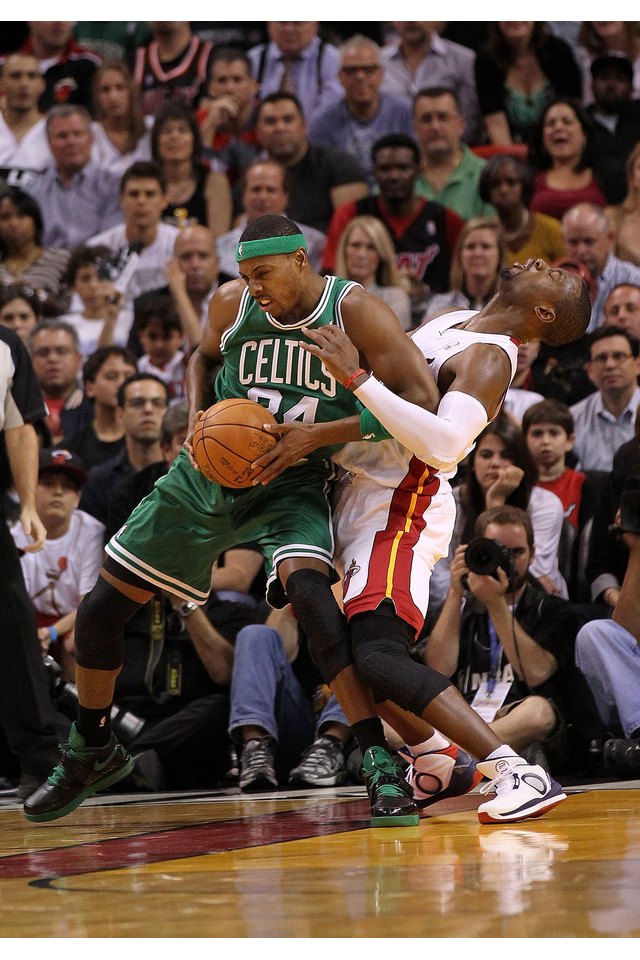Leading With an Elbow in Basketball

Competitive basketball is a highly physical activity where players engage in a wide range of legal and illegal contact. While referees may allow a certain amount of jostling and pushing on the court, striking an opponent with an elbow nearly always results in a foul call. Intentionally leading with or swinging an elbow when approaching an opponent can result in several different citations, ranging from a non-contact change of possession violation to ejection from the game and suspension from future contests.
Personal Foul
Leading with an elbow almost always puts the offending player in a position to receive a personal foul, since striking an opponent with the elbow is illegal according to National Basketball Association, Women's National Basketball Association and National Collegiate Athletic Association rules. An offensive player who hits a defender with his elbow while moving or jockeying for position receives a personal foul and the other team gets possession of the ball. If a defender strikes an offensive player with a leading elbow then he also receives a personal foul. The offensive team then either throws the ball in bounds from the sideline or the fouled player shoots free throws, depending on the number of fouls previously committed by the defensive team.
Flagrant Foul
Under both NBA and WNBA rules, a flagrant foul is a severe penalty that referees assess when a player makes reckless or unnecessary contact with an opponent. If a player moves toward an opponent and strikes her with an intentionally-extended elbow, then the officials may well deem the contact both reckless and unnecessary. The offending player receives a personal foul, while the fouled player shoots two free throws and her team maintains possession of the ball. If the officials decide that the elbow strike was meant to cause injury or particular reckless then they may assess a more severe flagrant, which has the same repercussions as a normal flagrant foul and also results in the offender's ejection from the game. All flagrant fouls are reviewed by the league office, which may assess the offender further punishment including a fine or suspension.
Swinging Elbow Violation
Most people who have watched or played basketball understand that hitting an opponent with your elbow is against the rules. Rule 10, Section X of the NBA rule book details a far less obvious violation that is unique to the NBA. The rule stipulates that a player who has possession of the ball can not engage in "excessive and/or vigorous swinging of the elbows" when he is in close proximity to opposing players - even if his elbows don't actually hit anyone. The purpose of the rule is to prevent players from swinging their elbows in an attempt to keep defenders from coming nearing. A player who commits this infraction does not receive a personal foul, since he did not make contact with an opponent, but his team loses possession and the other team passes the ball in from the sideline.
Drawing A Shooting Foul
Getting caught leading with an elbow is almost always a bad idea on the basketball court. There is a single exception to this rule that applies at all levels of professional and amateur basketball. When a player has the ball on the offensive, her defender will often attempt to stand as close as possible, leaving little space for the offensive player to operate. Inexperienced defenders occasionally make the mistake of extending their hands into the air space above the offensive player's arms. If you are facing the basket with the ball and your defender's arms stray into the path of your shooting motion, then you can draw a foul by attempting a shot and intentionally colliding with their arms. In the NBA, this tactic was perfected by Paul Pierce and Kevin Durant, for example.
This is the one situation in which leading with an elbow can be helpful; if the player's arms are slightly outside the range of your normal shooting motion. then you can extend the elbow of your shooting arm forward in an exaggerated manner to create contact while you shoot. The key is that your extended elbow contacts the bottom or side of the defender's arm during the upward portion of the shot. If that happens she receives a personal foul and you are rewarded with a trip to the free throw line.
References
Writer Bio
Dan Howard is a sports and fitness aficionado who holds a master's degree in psychology. Howard's postgraduate research on the brain and learning has appeared in several academic books and peer-reviewed psychology journals.
